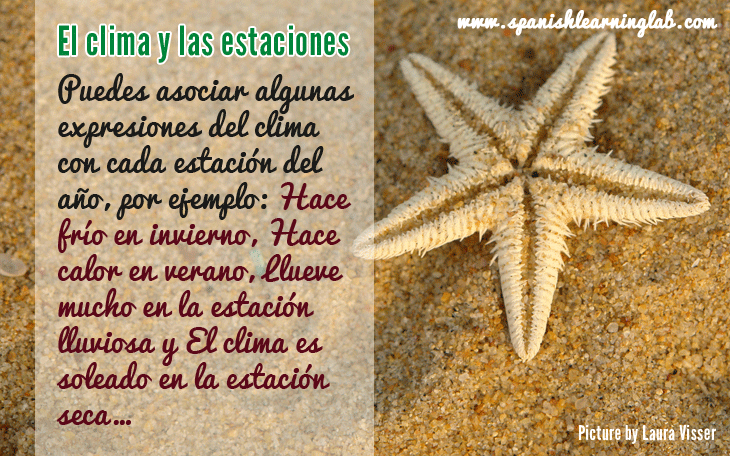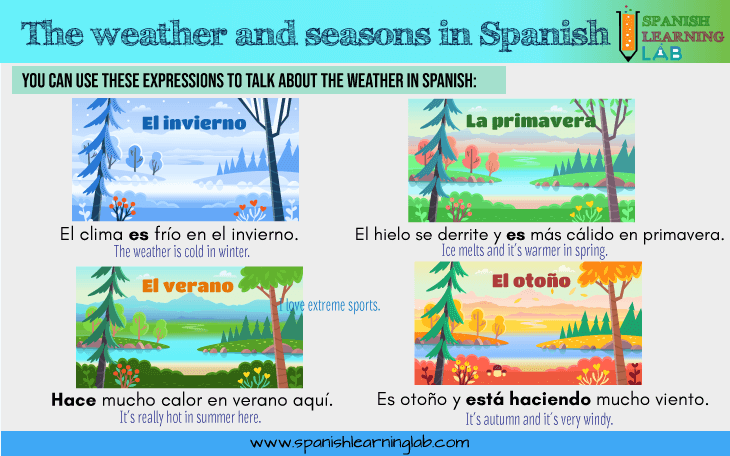Welcome! In this lesson, we will learn to talk about the weather and seasons in Spanish by using some basic structures and vocabulary covered in our previous lesson about weather descriptions and forecasts in a few interesting conversations about the weather and seasons in Spanish (EL CLIMA). This will give you more chances to practice Spanish listening. Comencemos…
Vocabulary introduction: The four seasons in Spanish
The expressions LAS ESTACIONES or LAS ESTACIONES DEL AÑO can be used to refer to the seasons in Spanish. Many countries have four seasons “cuatro estaciones del año”. The four seasons in Spanish are: OTOÑO (autumn), INVIERNO (winter), PRIMAVERA (spring) and VERANO (summer). Here a video showing you the four seasons through beautiful pictures plus a few important examples we will be using later in the conversations and some important notes. You will also find the two seasons for tropical countries.
Describing the weather and seasons in Spanish
SER and ESTAR for weather and seasons descriptions
Both SER and ESTAR are very useful for talking about the weather and seasons in Spanish. The verb ESTAR will be used to say what the weather is like at a given moment, that is temporary weather conditions, for example: “El clima está caliente”. On the other hand, SER will be used in a more descriptive and general way, for example: “El clima es caliente en mi ciudad” (the weather is hot in my city – it means it is generally hot). If instead we said “El clima está caliente en mi ciudad” it would mean that it is hot right now, but it may change soon.
Most of the time, sentences to describe the seasons in Spanish will follow the structure [Artículo definido (El/La) + season + SER (to be) + adjective]. Here are some basic examples, similar to the ones presented in the video: “La primavera es hermosa”, “El verano es una estación muy caliente” and “El otoño es colorido”. Listen to the first conversation about the weather and seasons in Spanish and pay attention to SER and ESTAR.
Example No. 1
- Fernando: ¡Ya llegó el verano! Es tiempo para ir a la playa
- Isabel: Si, ya estamos en verano. Hoy está haciendo mucho calor.
- Fernando: Bueno, el verano es una estación muy caliente aquí
- Isabel: Ni me lo digas, aquí siempre hace calor en verano. Lo bueno es que podemos ir a nadar a la playa ¿verdad?
- Fernando: Esa es la mejor parte de esta estación del año
¿Sabías qué?
La mayoría de los países de América latina son países tropicales, así que solo tienen dos estaciones al año: la estación seca y la estación lluviosa.
HACE + weather conditions in Spanish
Another very common way to talk about the weather in Spanish is by using the phrase “HACE” from the verb HACER plus weather conditions in Spanish. It would be the equivalent to “It’s” in English, for example: “Hace calor” (It’s hot). The main difference would be that we do not use a Spanish adjective after “Hace”, but a noun so saying “Hace caliente” is incorrect. You can also use “Estar + Hacer in gerund form” as shown in the conversation above, for example: “Está haciendo calor“.

In the next conversation, you will see SER, ESTAR and HACER in use. Notice that this conversation shows how to talk about your favorite season in Spanish and why you prefer a season over another. Click on play to listen to the example.
Example No. 2
- Isabel: El clima está muy frío hoy. En las noticias dicen que hoy va a caer nieve.
- Fernando: Es cierto, hoy está haciendo frío. Es porque estamos en invierno ¿A ti te gusta el invierno?
- Isabel: Sí, el invierno es mi estación favorita del año porque puedo esquiar y patinar sobre hielo
- Fernando: uh-mm… pues yo prefiero la primavera. Ya quiero que sea primavera porque el clima es más cálido y puedes hacer más cosas afuera
Saying what you like about the seasons in Spanish
“What is your favorite season?” in Spanish
In order to ask someone “What’s your favorite season?” in Spanish, you can use the questions ¿Cuál es tu estación favorita? and ¿Cuál es la estación que te gusta más?. You can answer with “Mi estación favorita es…” and “La estación que más me gusta es…”. Say why you like a season in Spanish with the “porque” (because) plus a simple weather description as in “Mi estación favorita es el invierno porque cae nieve“. Also remember you can use “Me gusta” to express likes in Spanish. Listen to these phrases and questions in the next conversation.

Example No. 3
- Isabel: ¿Cuál es tu estación favorita?
- Fernando: En mi país hay 4 estaciones del año. Mi favorita es el otoño porque las hojas cambian de color verde a dorado, amarillo y rojo… y el clima es agradable también.
- Isabel: Ya veo. En mi país solo tenemos dos estaciones. A mí me gusta la estación seca porque puedo ir a nadar a las playas
- Fernando: pero tú no vives cerca de la playa ¿verdad?
- Isabel: No, vivo lejos de la playa… El clima de mi ciudad es fresco y hay varios ríos también pero prefiero el mar
HAY + weather conditions and forecasts in Spanish
The last way to say what the weather is like in Spanish is using [Hay un clima + a weather condition in Spanish] or [El tiempo está + a weather condition in Spanish] like in these examples “Hay un clima soleado esta mañana” and “El tiempo está frío hoy”. You can ask about the weather in Spanish using ¿Cómo está el clima hoy? and ¿Cómo está el tiempo hoy?
As we explained in the previous lesson, we can make weather forecasts in Spanish using “ESTARÁ” (will be), “HABRÁ” (there will be), “CAERÁ” (It will fall) and “HARÁ” (there will be). Check how weather descriptions and forecasts in Spanish are used in a conversation.
Example No. 4
- Isabel: Llueve bastante en esta ciudad. El cielo está nublado y a veces hay tormentas eléctricas.
- Fernando: Es porque estamos en la estación lluviosa. La estación seca terminó hace dos meses. Las tormentas son normales en esta estación del año.
- Isabel: Espero que no haya huracanes…
- Fernando: No creo. El pronóstico del tiempo dice que el cielo estará despejado en los próximos días, con algo de viento y temperaturas moderadas.
- Isabel: Ese es un buen reporte.
Listening Activity No. 1: The weather and seasons in Spanish
Key expressions in the conversation:
- “Tengo ganas de…” means “I feel like…”
- “Los árboles se ponen de color verde” means “The trees turn green”
- “Seguro se debe a…” means “It must be because of…”
Listening Activity No. 2: Weather expressions and questions in Spanish
We hope you enjoyed learning about the seasons in Spanish with us. ¡Nos vemos pronto!
Related Spanish Worksheets:
- The Vocabulary for the Weather in Spanish
- Describing the Weather in Spanish
- Weather conversation cards in Spanish
- Months of the Year and the Weather in Spanish (Dialogues)
- My Favorite Season in Spanish (Reading)
- Countries with Tropical Weather (Reading)
